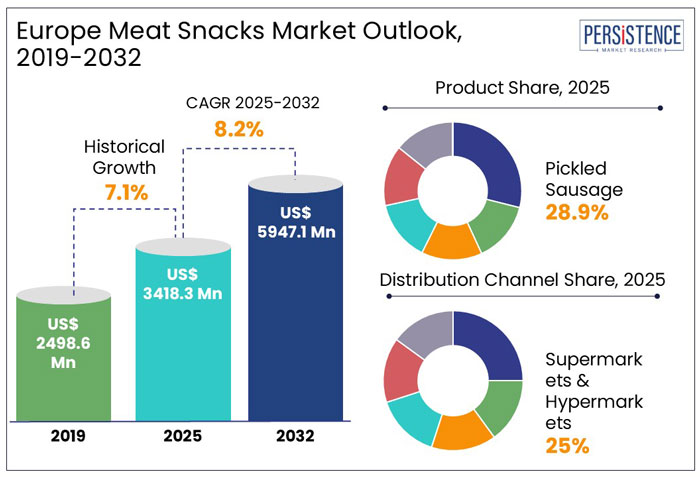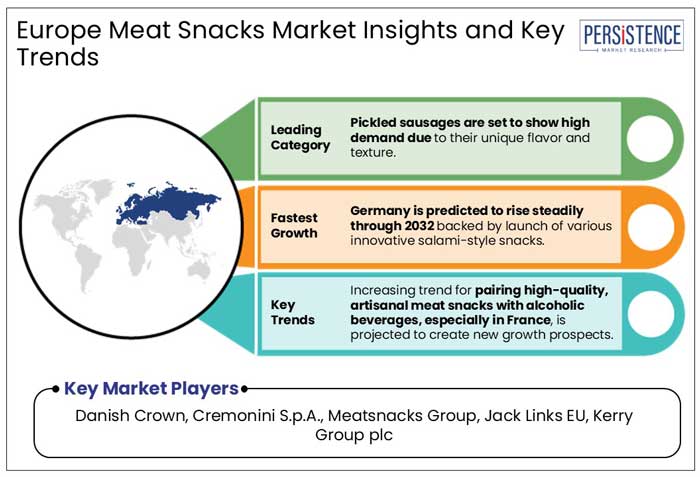Europe Meat Snacks Market
Industry: Food and Beverages
Published Date: February-2025
Format: PPT*, PDF, EXCEL
Delivery Timelines: Contact Sales
Number of Pages: 184
Report ID: PMRREP35137
The Europe meat snacks market size is anticipated to reach a value of US$ 3,418.3 Mn in 2025 and is set to witness a CAGR of 8.2% from 2025 to 2032. The market will likely attain a value of US$ 5,947.1 Mn in 2032.
Imagine grabbing a quick bite on the go- something that is easy to carry, packed with unique flavor, and high in protein. For this reason, meat snacks have become a huge hit in Europe, transforming from conventional dried meats into a thriving market that appeals to busy professionals, fitness enthusiasts, and health-conscious customers.
With rising demand for beef jerky, biltong, and salami sticks, Germany, the U.K., and France are leading the market, while Scandinavia is adopting cutting-edge reindeer and elk-based snacks. To appeal to adventurous palates, key players are introducing exotic flavors enhanced with local spices. The competitive landscape is being further transformed by the emergence of vegan and hybrid meat snacks, which combine traditional meats with plant-based proteins.

Key Highlights of the Europe Meat Snacks Industry
|
Market Attributes |
Key Insights |
|
Europe Meat Snacks Market Size (2025E) |
US$ 3,418.3 Mn |
|
Market Value Forecast (2032F) |
US$ 5,947.1 Mn |
|
Projected Growth (CAGR 2025 to 2032) |
8.2% |
|
Historical Market Growth (CAGR 2019 to 2024) |
7.1% |
Post-pandemic Fitness Boom and Health Consciousness Drove Meat Snack Sales in Europe
In the historical period from 2019 to 2024, the Europe meat snacks industry witnessed a CAGR of 7.1%. Due to a rise in new gym and fitness club memberships, the fitness market in Europe grew significantly in the post-pandemic era. Increasing health consciousness among older demographics resulted in the adoption of healthy diets, especially the ones with high protein content. Countries like Sweden, Norway, Denmark, and Switzerland were at the forefront of the younger generation's surging health consciousness in the historical period.
In response, key companies came up with unique meat snacks that are rich in protein and low in calories and fat. These products were launched in a wide range of flavors and textures, making meat snacks a more popular choice among customers than traditional junk food. Hence, a growing emphasis on better snacking practices supported market growth from 2019 to 2024.
Traditional Meat Snacks to Gain Traction in Forecast Period as Consumers Seek Authentic Flavors
From 2025 to 2032, the Europe meat snacks market is likely to showcase a CAGR of 8.2%. Rising interest of consumers in meat snacks infused with exotic and diverse flavors is anticipated to boost growth in the future.
A wide variety of traditional meat snacks with distinct flavors that represent their regional origins can be found in Europe's rich culinary heritage. For instance, in the Nordic regions, reindeer jerky is a delicacy. This lean, tender meat is often seasoned with indigenous herbs, providing a distinct taste of the Arctic wilderness. Companies are set to capitalize on this trend by launching traditional regional specialties in the form of snacks.
Growth Drivers
Future of Meat Snacks in Europe Lies in Premium, Organic, and High-quality Offerings
The trend toward premiumization in the food and beverage industry is anticipated to propel the Europe meat snacks market in the forecast period. Customers are increasingly looking to spend money on snacks that fit these standards as their tastes move toward healthier and better options.
Several manufacturers are hence innovating with premium product offerings that emphasize artisanal production methods, organic ingredients, and high-quality meats. These products are anticipated to cater to those consumers seeking indulgent yet nutritious snack options. This strategic move is projected to not only meet changing consumer needs but also position companies to capitalize on the surging premium meat snacks segment in Europe.
Europe Meat Snacks Industry Faces Supply Chain Bottlenecks Due to New Import Rules
Disruptions in supply chain are anticipated to significantly affect the meat snacks industry in Europe through 2032. The U.K.’s departure from the European Union (EU) gave rise to new regulatory frameworks that have disrupted meat supply chains.
In February 2024, the implantation of the Border Target Operating Model (BTOM) required health certificates for all high- and medium-risk products imported from the EU, including dairy and meat. This sudden change resulted in high potential delays at borders and administrative burdens. It further affected the timely availability and import process of meat products in the U.K.
Companies to Shift to Hybrid Meat Snacks to Cater to Flexitarian Consumers
A new market for flexitarian customers is being created by hybrid meat snacks, which blend ingredients from both plants and animals. While preserving familiar aromas and textures, these products seek to lower the meat content.
Several European businesses are leading the way in this field. A renowned meat-free products company called Quorn, for example, announced plans to produce blended meat-mycoprotein products, containing 50% of meat and 50% mycoprotein. Lidl Netherlands, on the other hand, launched a hybrid beef and pea protein burger, striving to cater to the needs of consumers looking to lower meat consumption without completely eliminating it. These innovations are projected to indicate a rapid shift in the field of meat snacks across Europe, with hybrid products gaining momentum.
Product Insights
Distinctive Taste and Extended Shelf-life to Boost Popularity of Pickled Sausages in Europe
By product, the pickled sausage segment is anticipated to hold a Europe meat snacks market share of 28.9% in 2025. It is attributed to the product’s distinctive flavor and characteristics. By using the unique flavoring and preservation method of pickling, these snacks create a novel category in the Europe meat snacks industry.
In this process, the sausage is marinated in a brine solution, which is usually made up of salt, vinegar, and spices. It gives the meat a distinctively fiery and acidic flavor. Pickling is capable of extending the product's shelf life in addition to improving its flavor. It translates to a long-lasting and convenient snack choice for consumers in Europe.
Jerky, on the other hand, is predicted to witness a considerable CAGR through 2032. Several health benefits, including minimal processing, low fat, and high protein content are responsible for the rising demand for jerkies. These are also available in various textures and flavors, which cater to the requirements of consumers looking for exciting yet diverse snack options.
Jerky has further gained traction among the younger demographics across Europe as these are now considered an energy booster or a post-workout snack. Athletes, especially runners and weightlifters, are projected to be the prime consumers of jerkies as these are a rich source of protein.
Distribution Channel Insights
Bundled Offers and Seasonal Discounts in Supermarkets to Push Meat Snack Purchases
In terms of distribution channel, the supermarkets and hypermarkets segment will likely hold a share of 26.4% in 2025. This growth is mainly due to the robust presence of several supermarket retail chains across Europe. Carrefour (France), Tesco (U.K.), and Schwarz Group (Germany) are a few leading regional retail chain businesses.
They provide a wide range of meat snacks catering to varying consumer preferences. Additionally, for busy consumers looking for on-the-go snacking options, the one-stop shopping experience streamlines the purchasing process.
Retail chains across Europe are projected to adopt promotional strategies, such as bundled offerings and seasonal discounts to push sales. Dedicated snack sections and eye-catching shelf placement are also anticipated to initiate impulse purchases and boost product visibility. For instance,
Restaurants are estimated to showcase a steady growth rate in the forecast period backed by the presence of a wide network of restaurant chains across Europe. Since European consumers are increasingly opting to snack outdoors rather than indoors, restaurants are regarded as an essential distribution channel for meat snack manufacturers. Restaurants also provide customers with the ease of healthy snacking, menu flexibility, and customization to meet their unique requirements and tastes.

Germany Meat Snacks Market
Germany’s Meat Snack Industry to Thrive on Heritage, Innovation, and Premium Offerings
Germany is anticipated to hold a share of 39.1% in Europe meat snacks market in 2025. Due to the country’s long-standing fondness for sausages, air-dried salami-style products have historically been the most widely consumed and easily accessible dry meat snacks in Germany. As per studies, in 2016, a quarter of Germans snacked on meat products.
The industry has evolved in recent years, with a greater emphasis on premium ingredients and innovative formats, even while salami-style snacks continue to dominate. Some products, such as Windau's Salami Nuggets with Parmesan, for instance, contain specific types of cheese, whereas Houdek's air-dried mini-salami brand is ripened with fine edible mold and refined with walnuts.
Significantly, an array of unique formats has emerged, pushing the boundaries of meat snack innovation. For example, described as handcrafted crisps produced from very thinly sliced chunks of meat that are dried and seasoned, Vulcano Schinkenmanufaktur from Austria has introduced an intriguing line of crisp-style meat treats in Germany. The resurgence of the meat snack segment in Germany can be primarily ascribed to a wide range of products with more unique, high-end ingredients.
U.K. Meat Snacks Market
Parents in the U.K. to Opt for Meat Snacks as Wholesome Back-to-school Lunchbox Solutions
The U.K. is projected to witness significant growth trajectory in the foreseeable future, with shifting consumer preferences creating new avenues. A key driver is the Back-to-School season, which saw 24 million occasions in September 2023 in the U.K.
Meat snacks are a tempting option for parents looking for wholesome yet delicious ways to keep their kids interested during snack time. They meet the demand for tasty yet convenient lunchbox alternatives as they are high in protein and come in a variety of exciting flavors.
Taste is the most important aspect affecting consumer purchases. Hence, businesses in the U.K. should give it high priority if they want to maximize sales potential. Offering a wide variety of enticing flavors, from delicately seasoned chicken bites to flavor-packed beef jerky, might encourage repeat purchases.
As healthy snacking becomes highly popular, companies that develop meat snacks made with natural, low-fat, and low-sodium ingredients stand a better chance of gaining market share in the U.K. The market is projected to surge as nutrition and convenience remain key purchasing drivers.
France Meat Snacks Market
Apéritif Culture to Propel Meat Snack Sales in France as Charcuterie Boards Gain Popularity
Demand for high-quality, artisanal meat snacks has been fueled by France's rich culinary legacy. Products like gourmet biltong, dry-cured ham chips, and saucisson bites, which are frequently flavored with local ingredients like black truffle and herbs de Provence, are attracting consumers. The desire for premium, minimally processed meats that provide a genuine flavor experience is reflected in this trend.
In France, the custom of serving meat snacks with alcoholic drinks is ingrained in the apéritif culture, which is a get-together of friends and family to enjoy drinks and small morsels prior to a dinner. Charcuterie boards are now a common sight in both formal and informal settings, demonstrating how this custom has changed over time.
Key companies in the Europe meat snacks market are focusing on product innovation and strategic expansions to strengthen their position. They are mainly investing in premiumization of products, further delivering convenient, clean-label, and high-protein meat snacks to meet changing consumer needs.
A few companies are leveraging their robust distribution channels as well as innovative processing technologies to maintain a competitive edge. Small-scale companies, on the other hand, are striving to differentiate their products from their competitors with targeted retail collaborations and novel product ranges to improve consumer engagement and visibility.
The market is also witnessing a surging influence of plant-based meat snacks. This change demonstrates the increasing rivalry between producers of conventional meat snacks and businesses that use plant-based or hybrid meat substitutes.
Key Industry Developments
|
Report Attributes |
Details |
|
Historical Data/Actuals |
2019 - 2024 |
|
Forecast Period |
2025 - 2032 |
|
Market Analysis Units |
Value: US$ Bn/Mn, Volume: As applicable |
|
Geographical Coverage |
|
|
Segmental Coverage |
|
|
Competitive Analysis |
|
|
Report Highlights |
|
|
Customization and Pricing |
Available upon request |
By Product
By Distribution Channel
By Country
To know more about delivery timeline for this report Contact Sales

The market is set to reach a value of US$ 3,418.3 Mn in 2025.
Danish Crown, Cremonini S.p.A., and Meatsnacks Group are the key brands in Europe.
The market is anticipated to reach a size of US$ 5,947.1 Mn by 2032.
The industry is projected to witness a CAGR of 8.2% through 2032.
Pickled pork sausages are the most consumed meat snack in Europe.